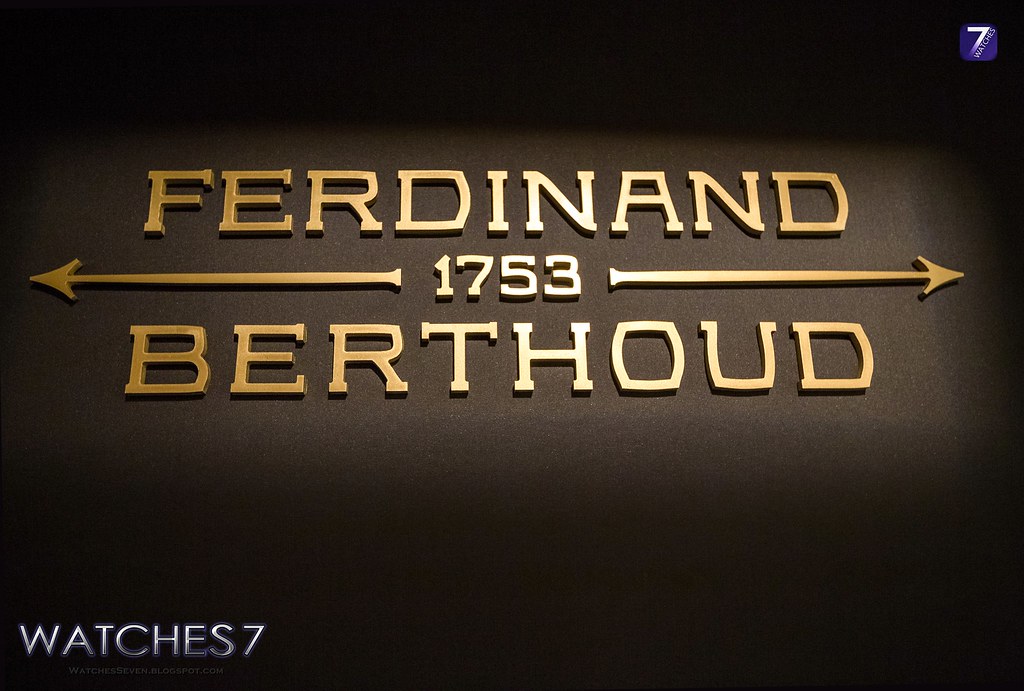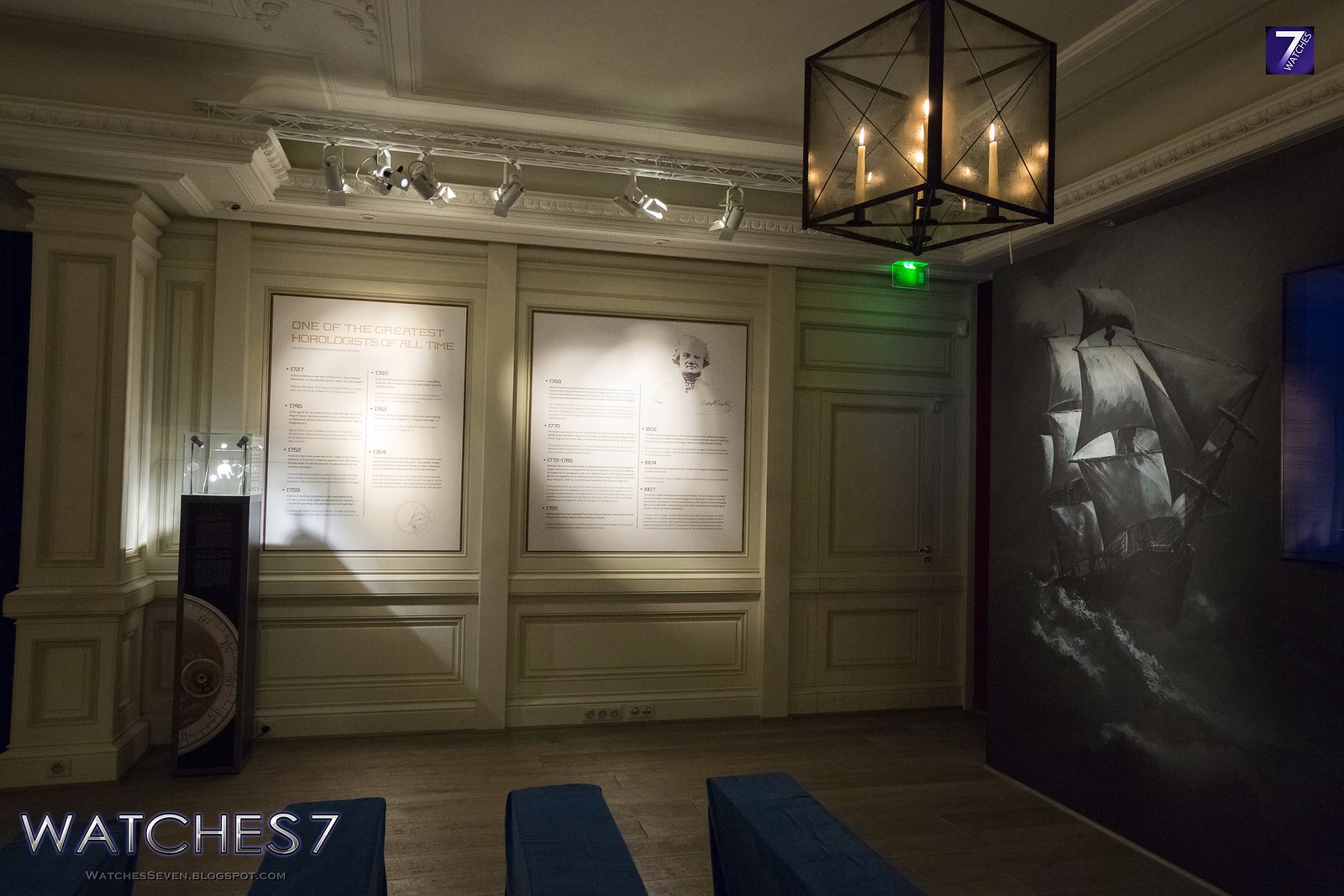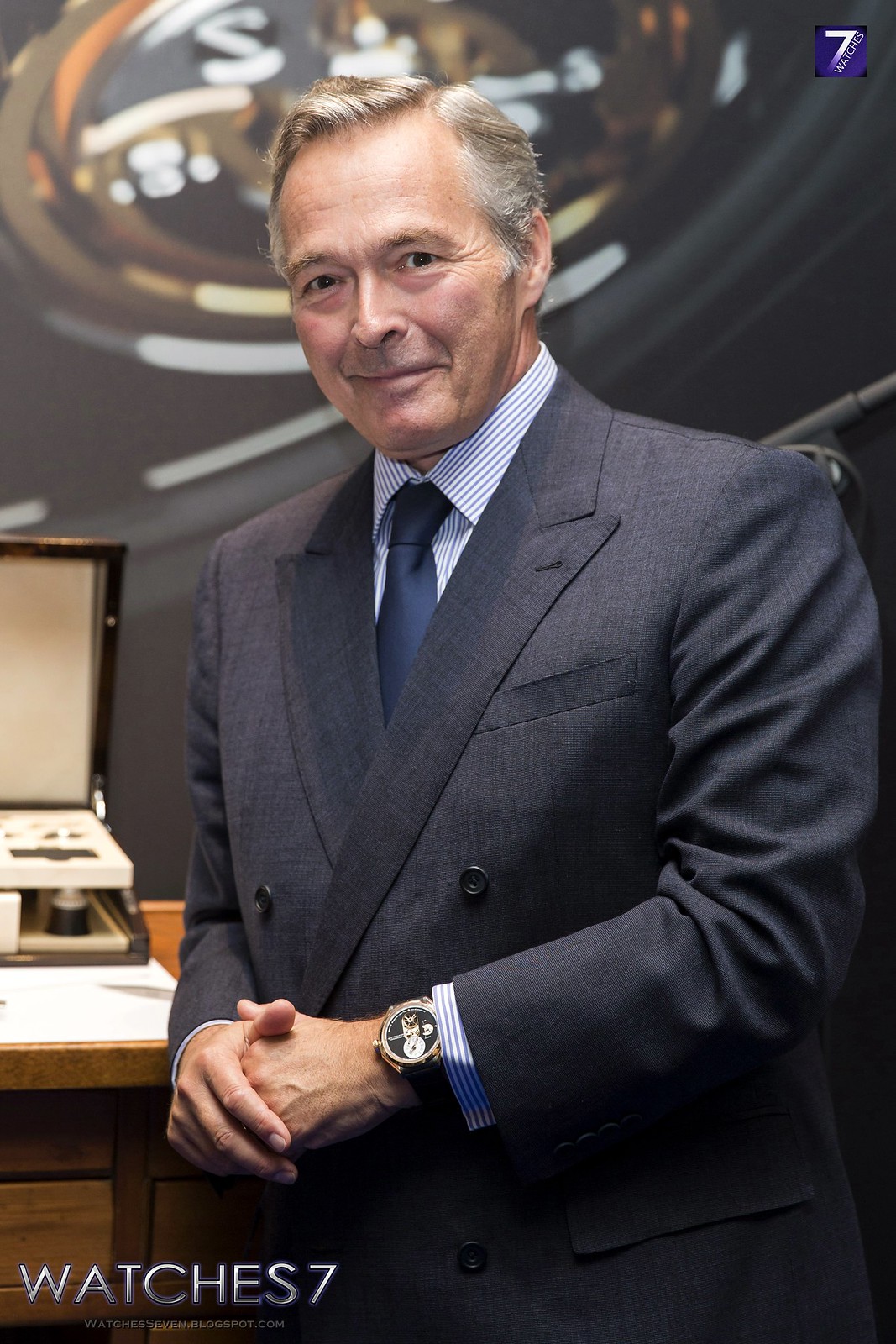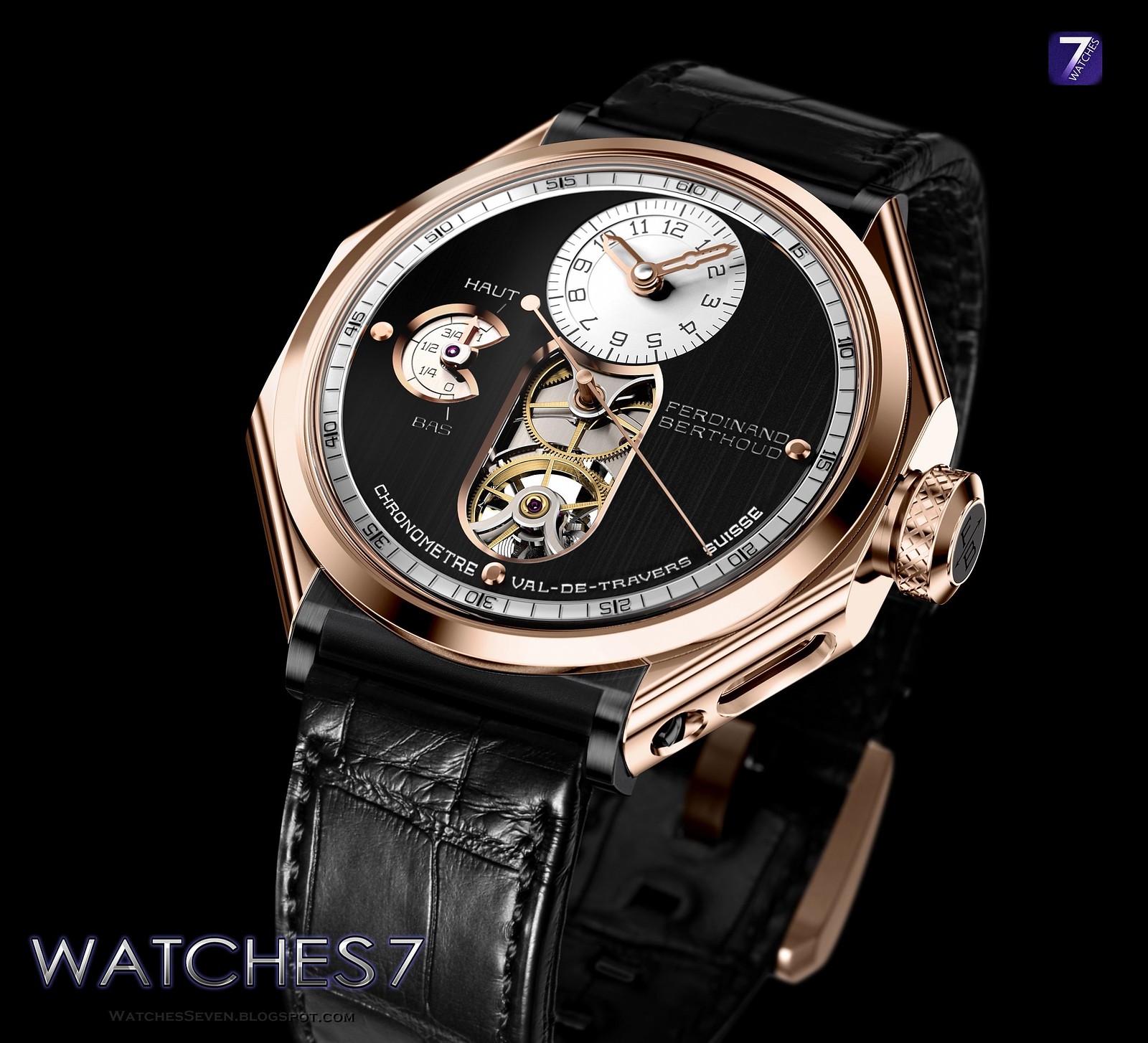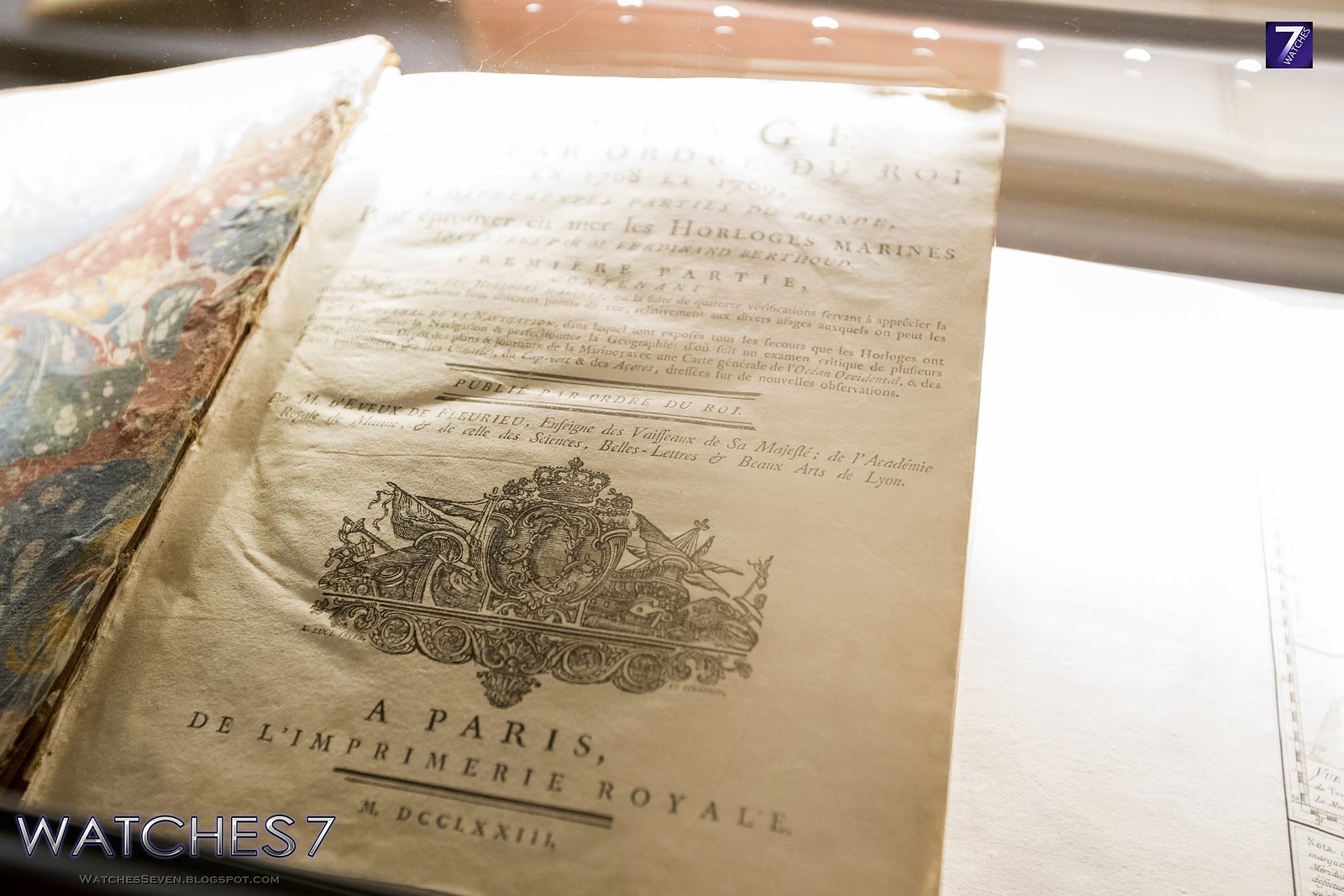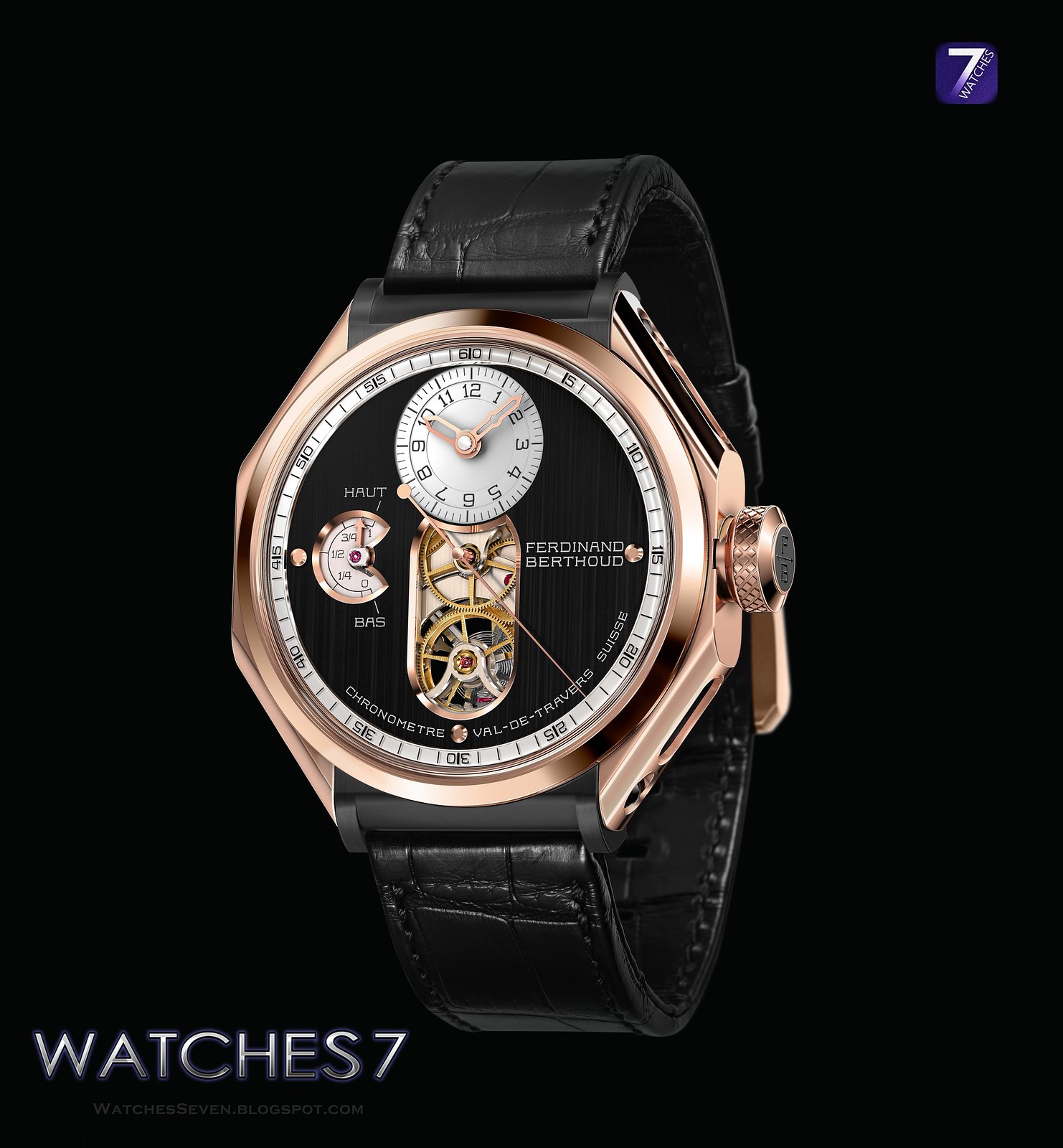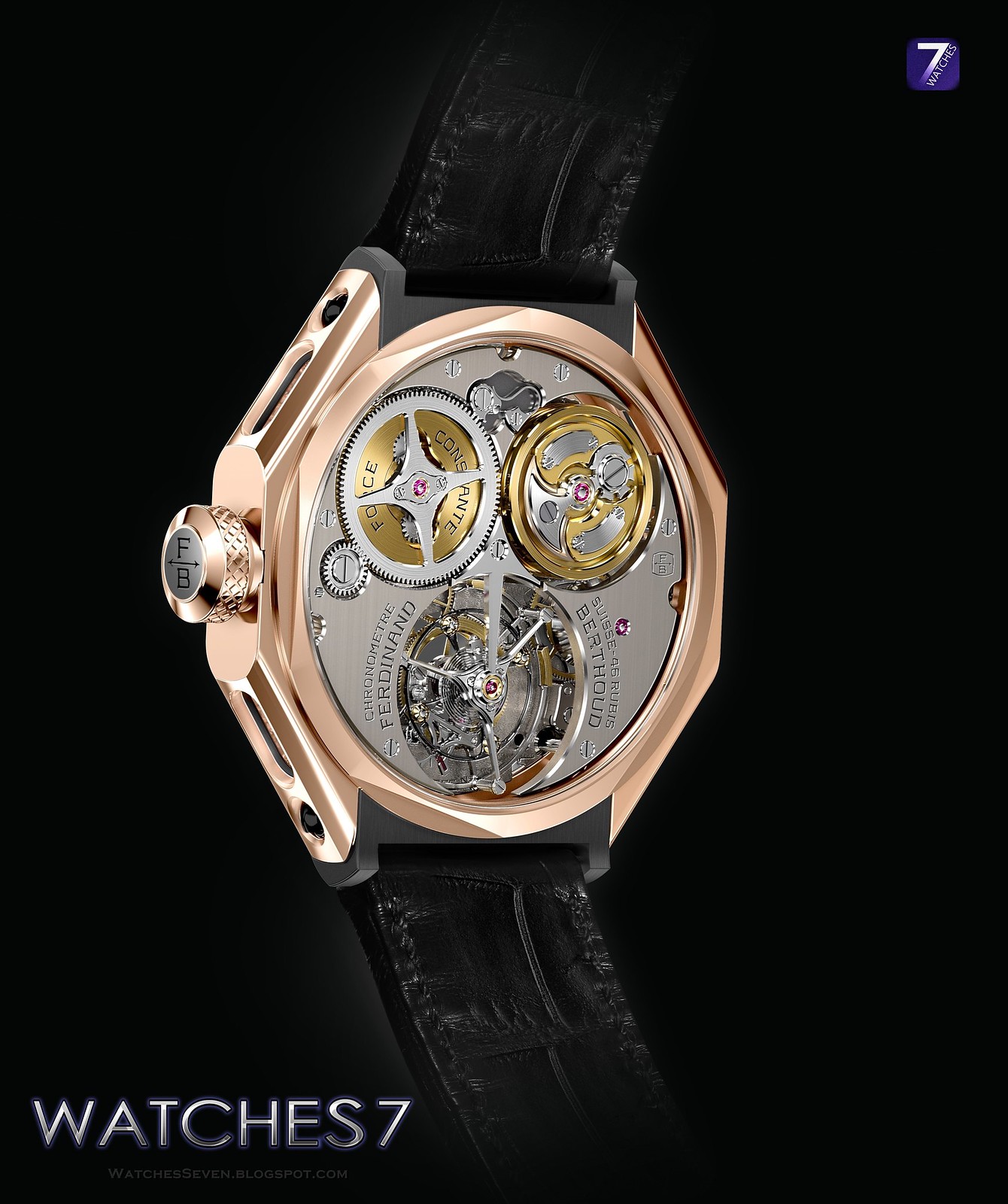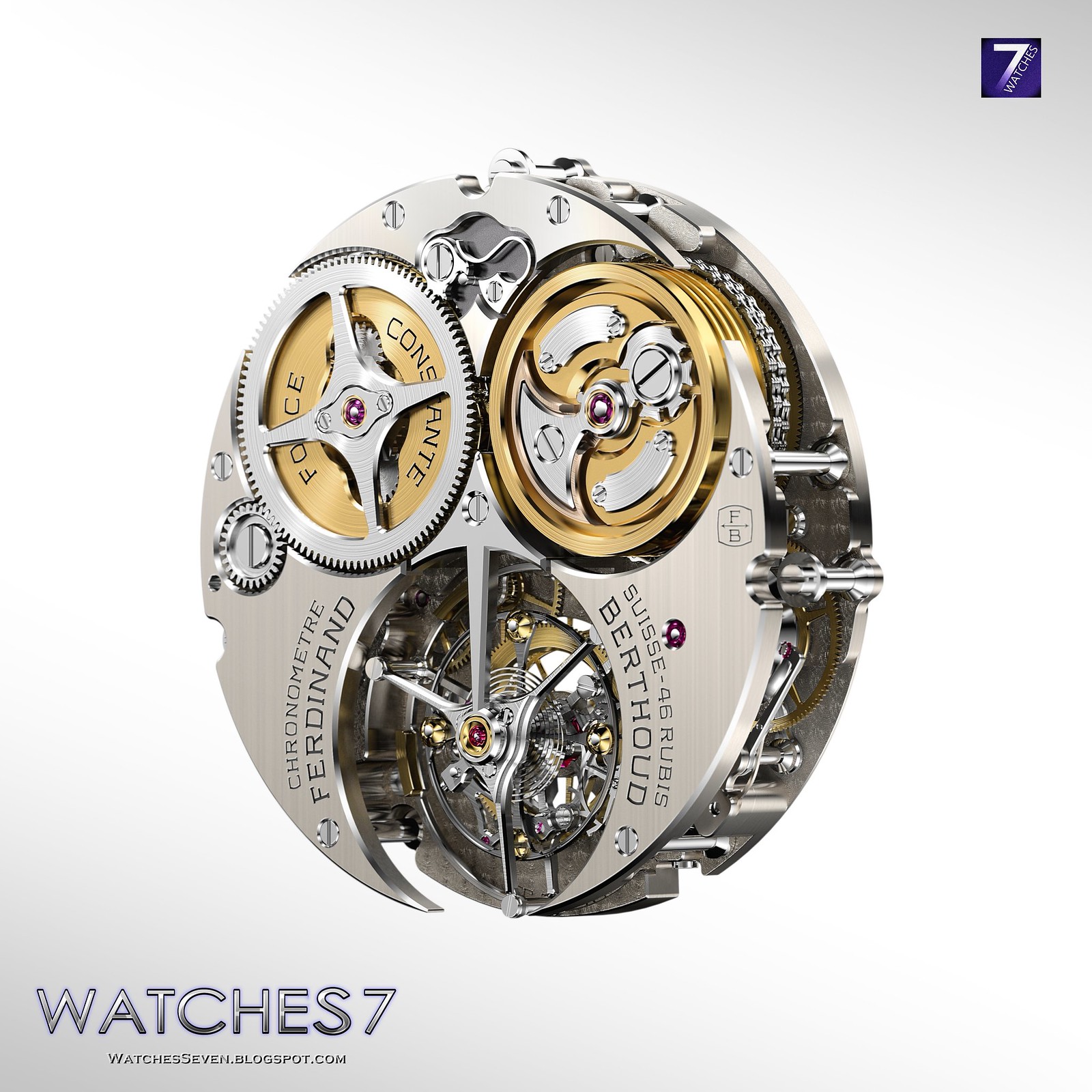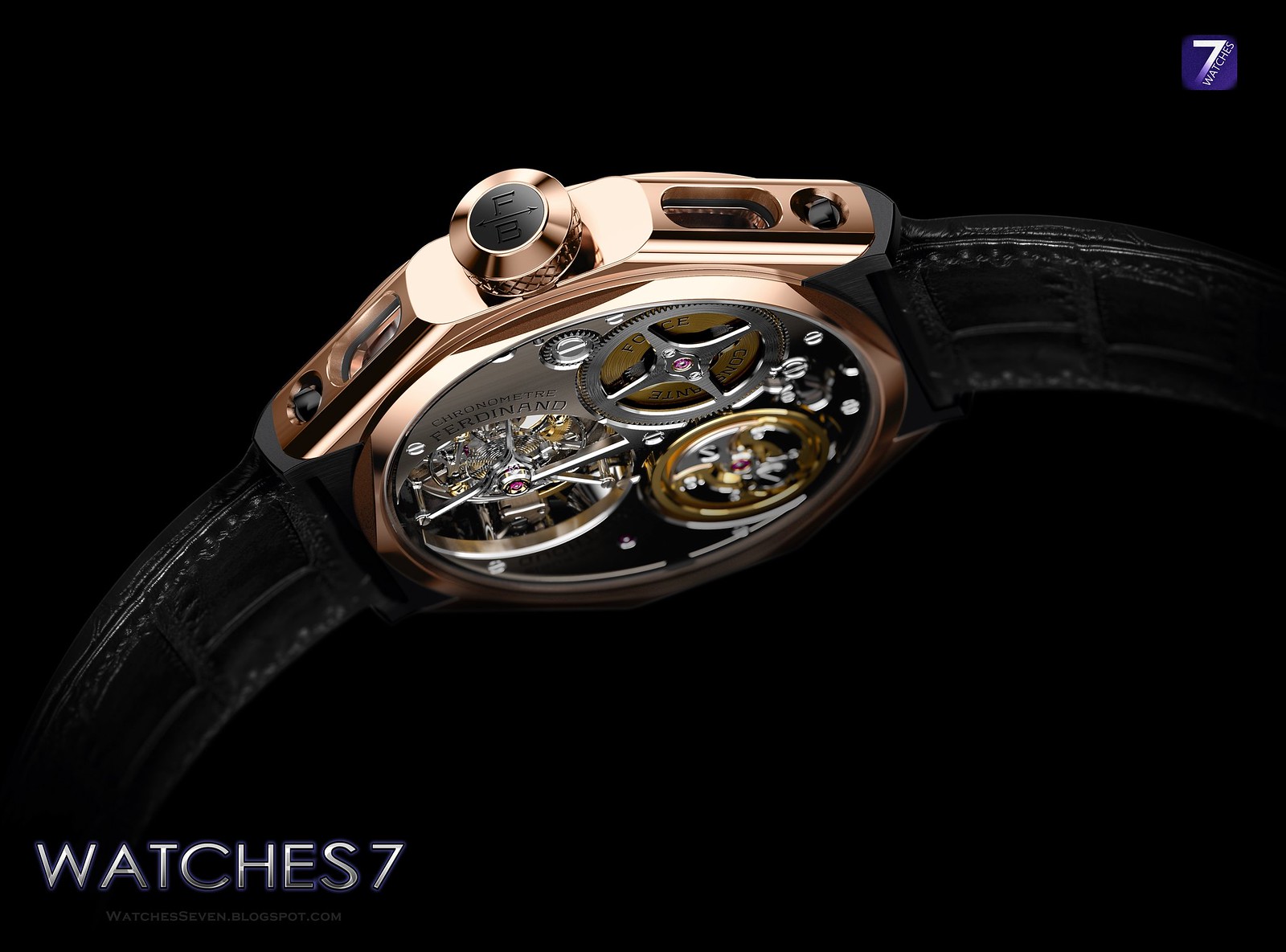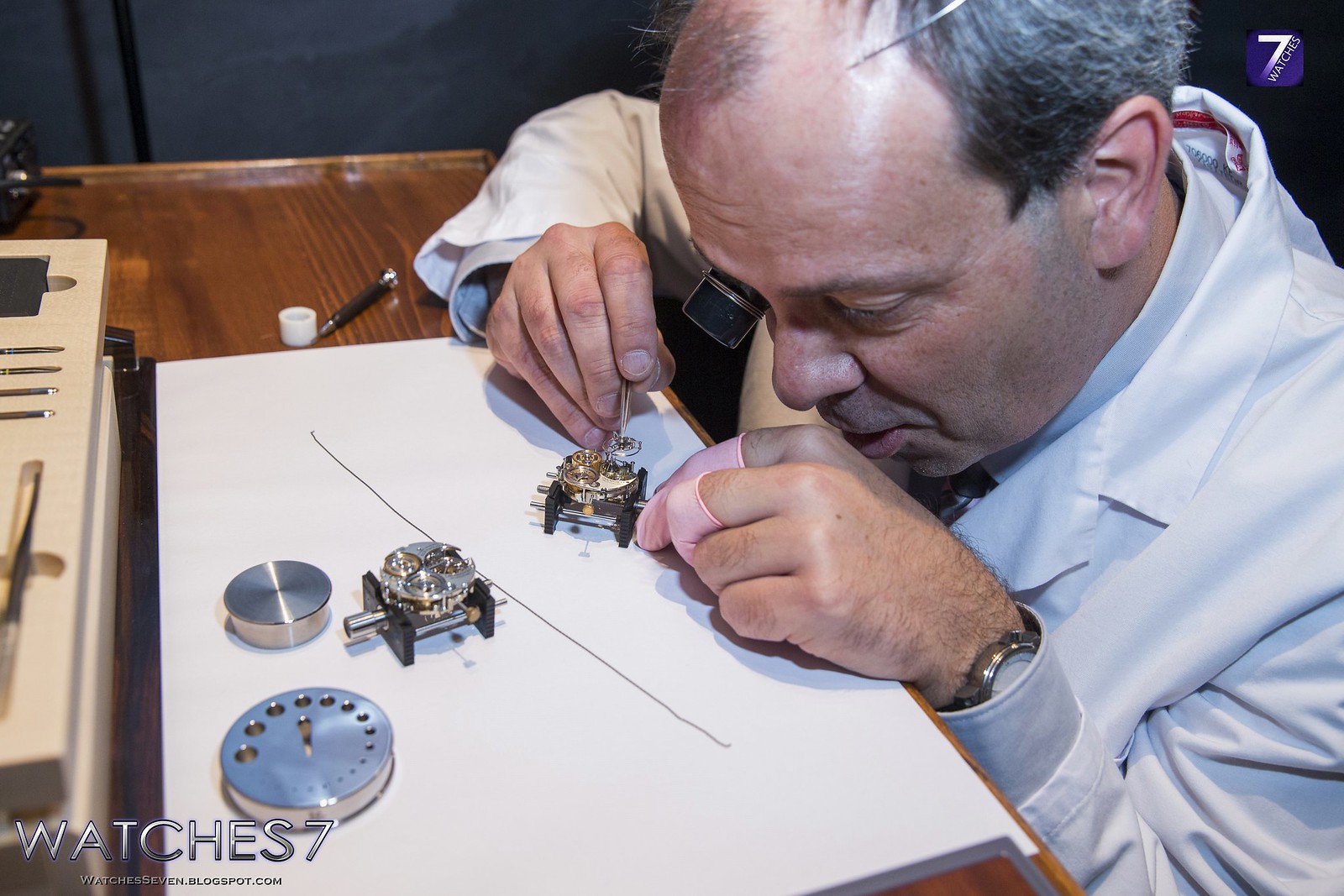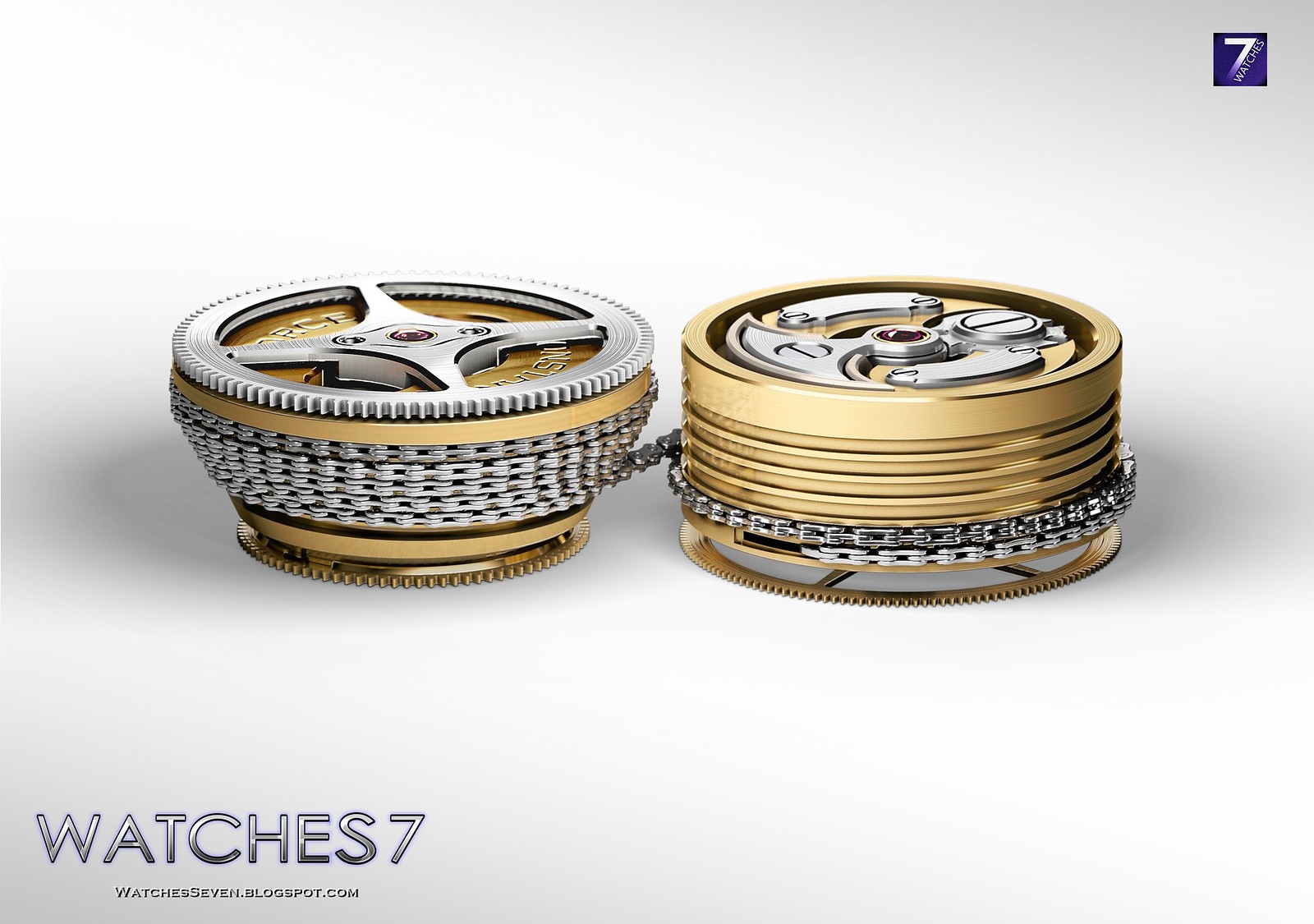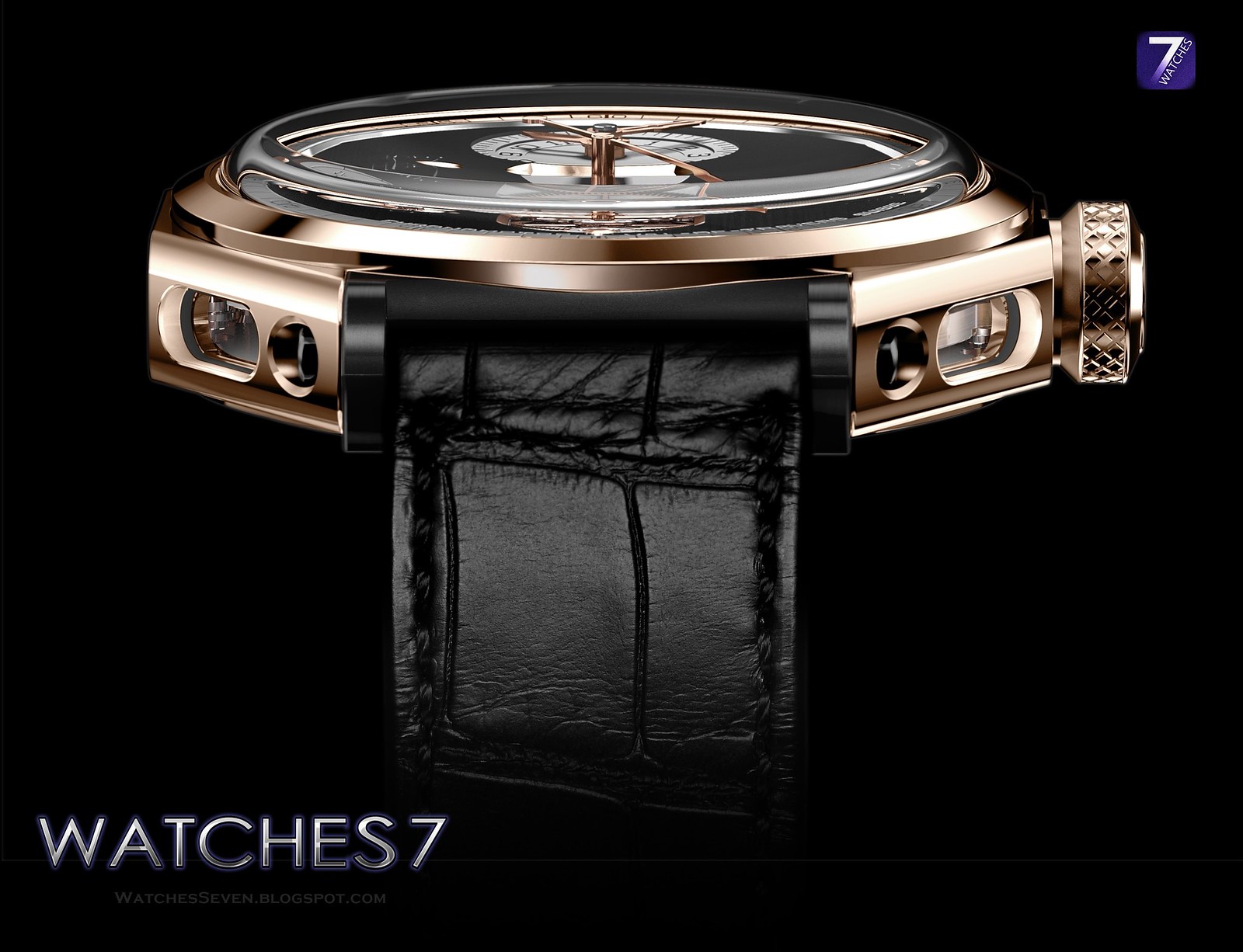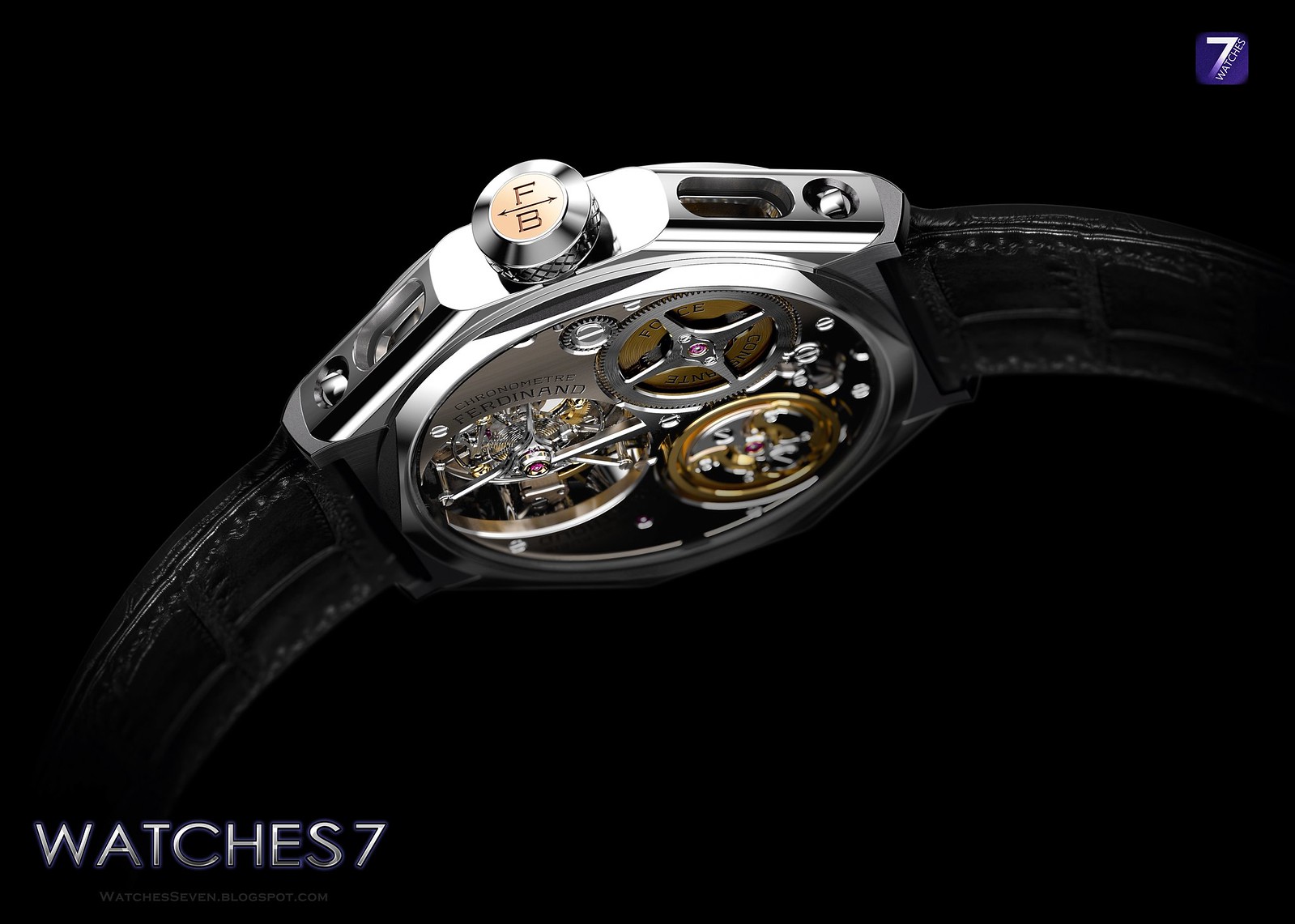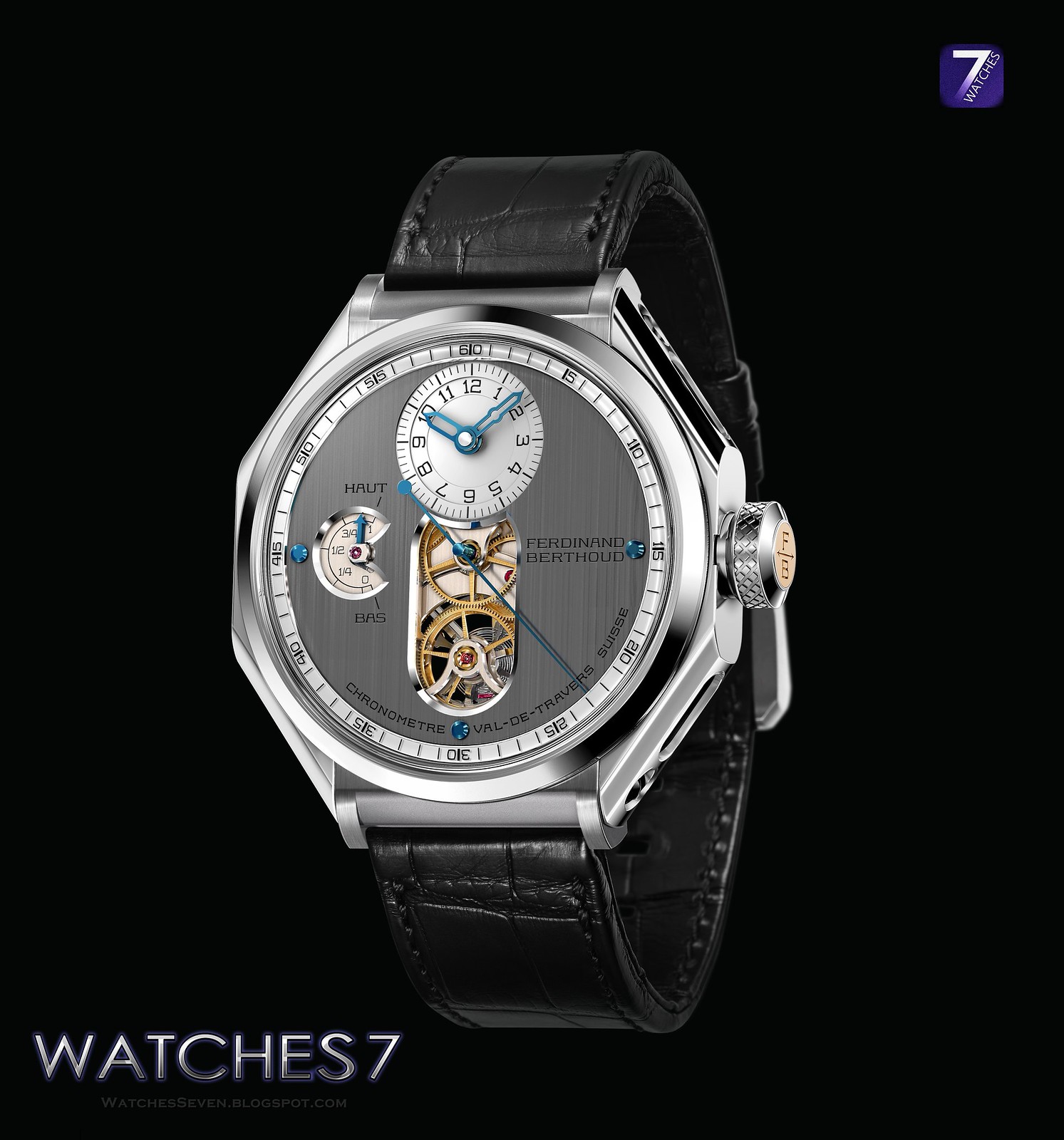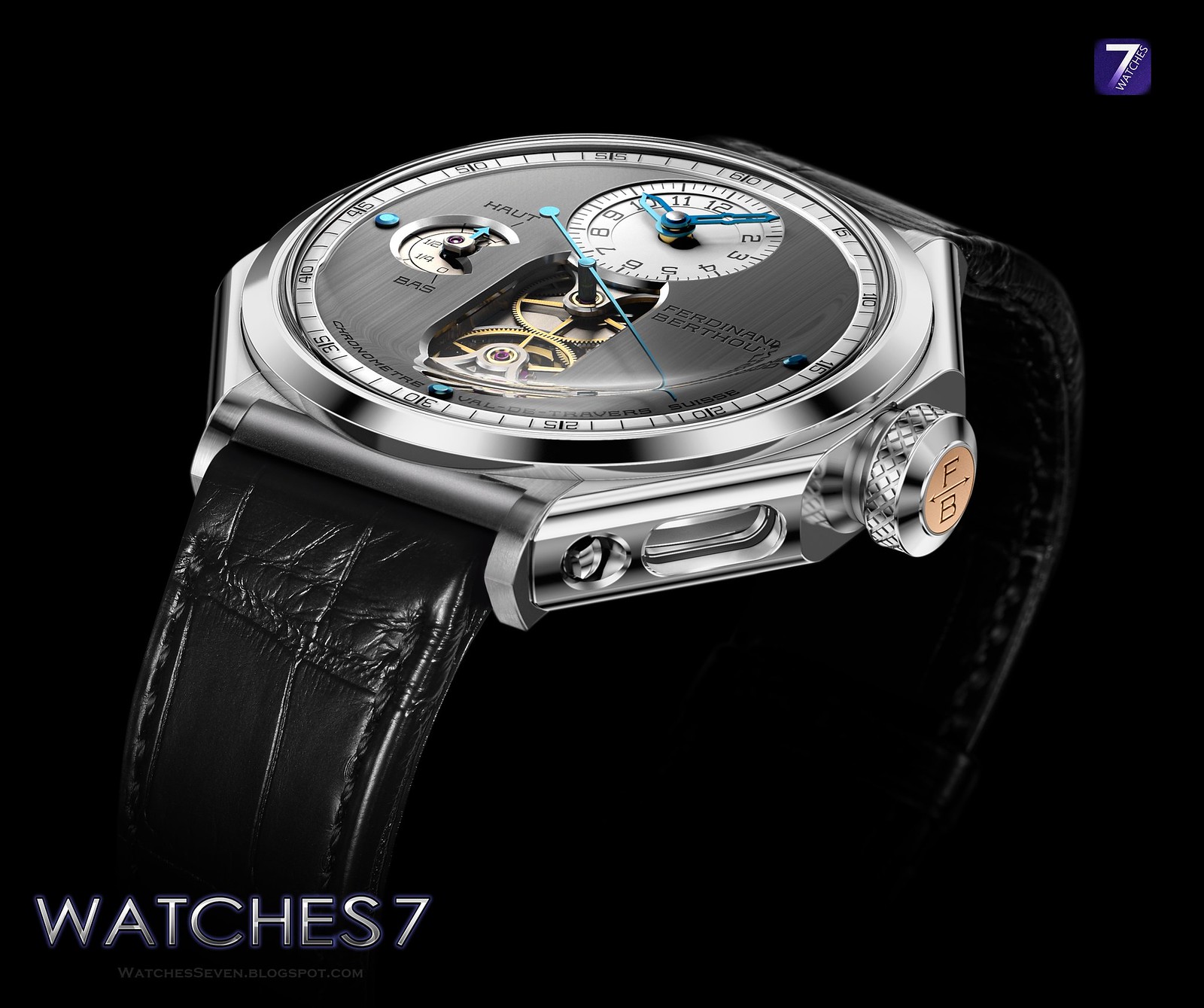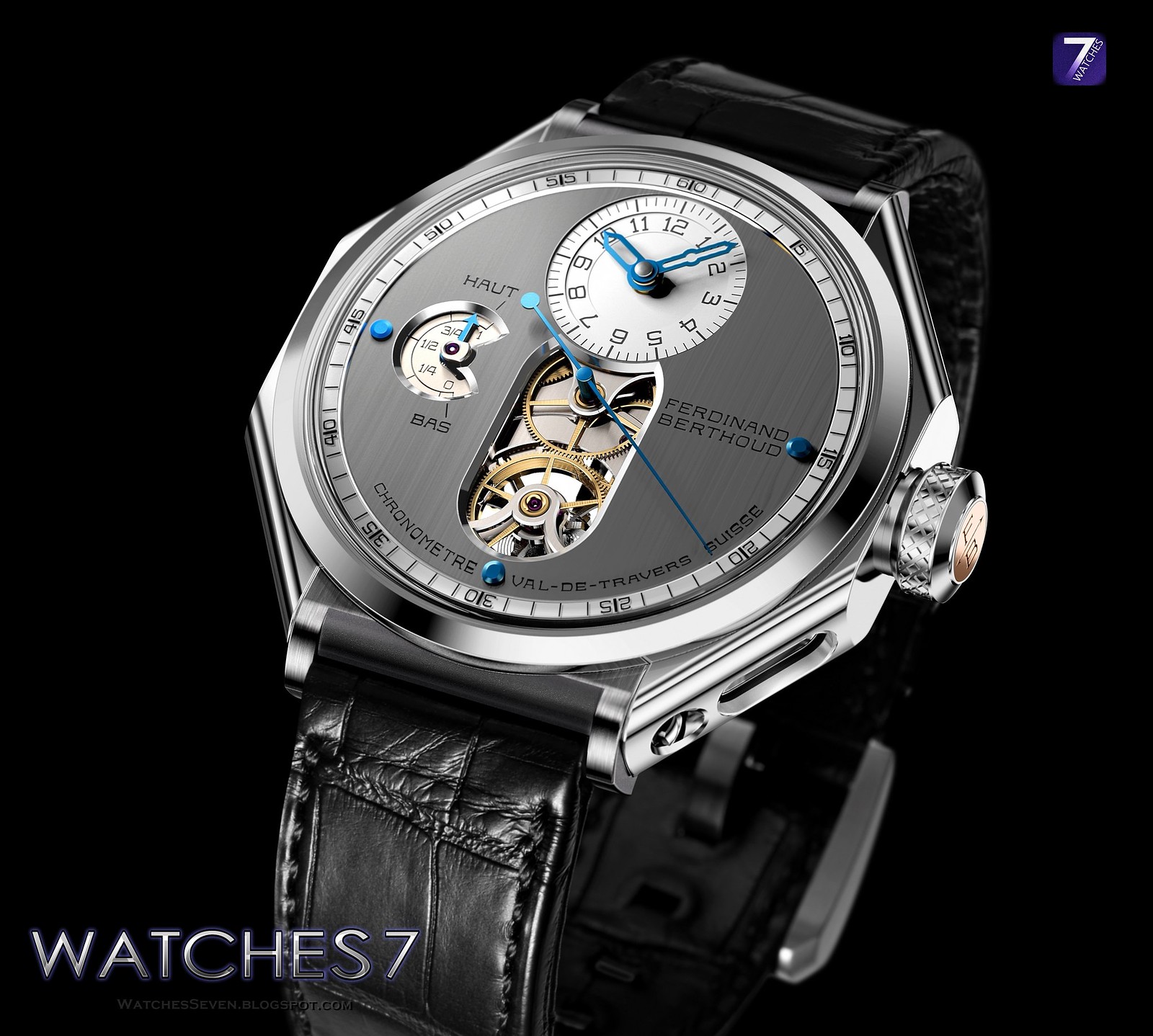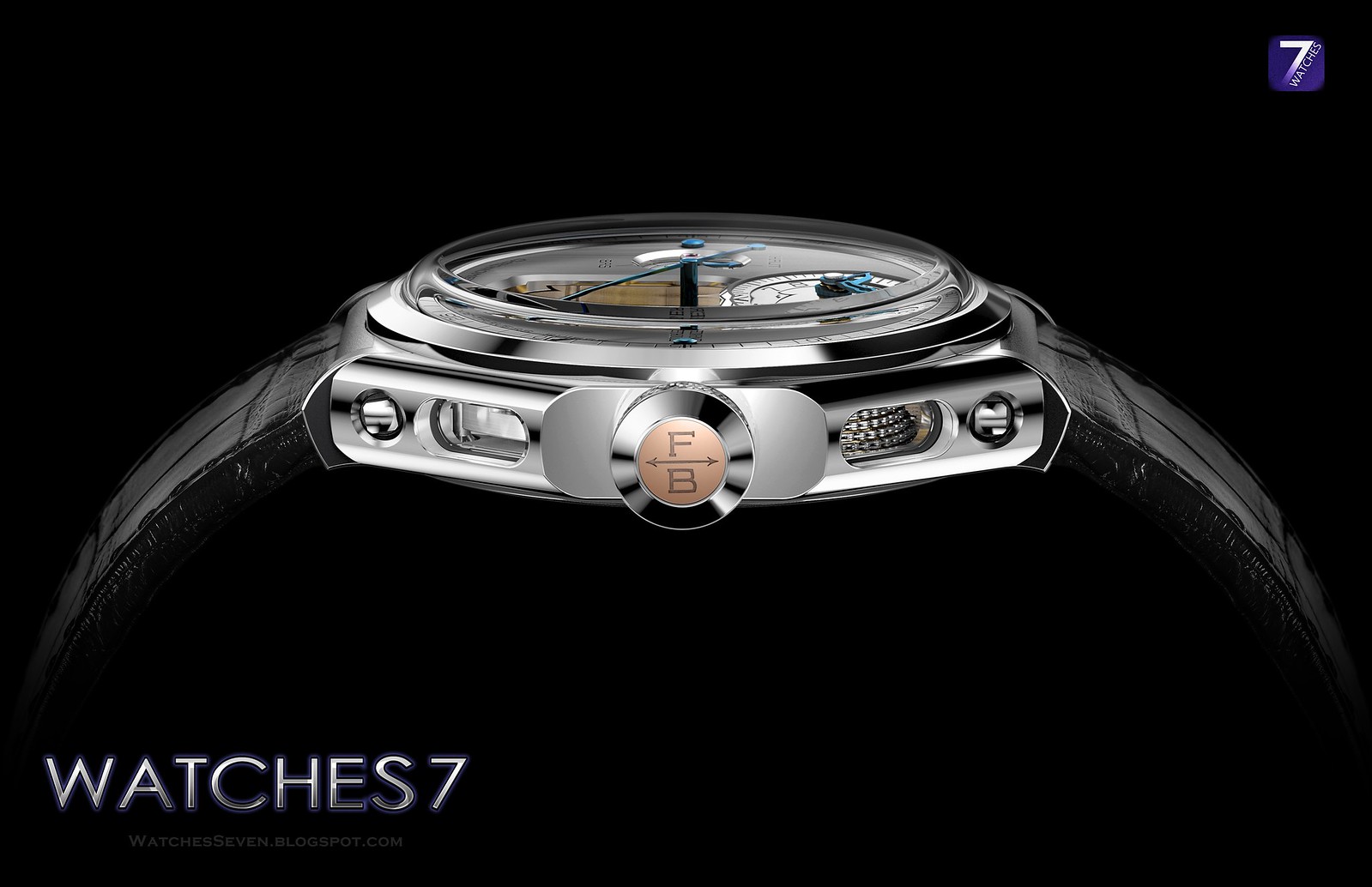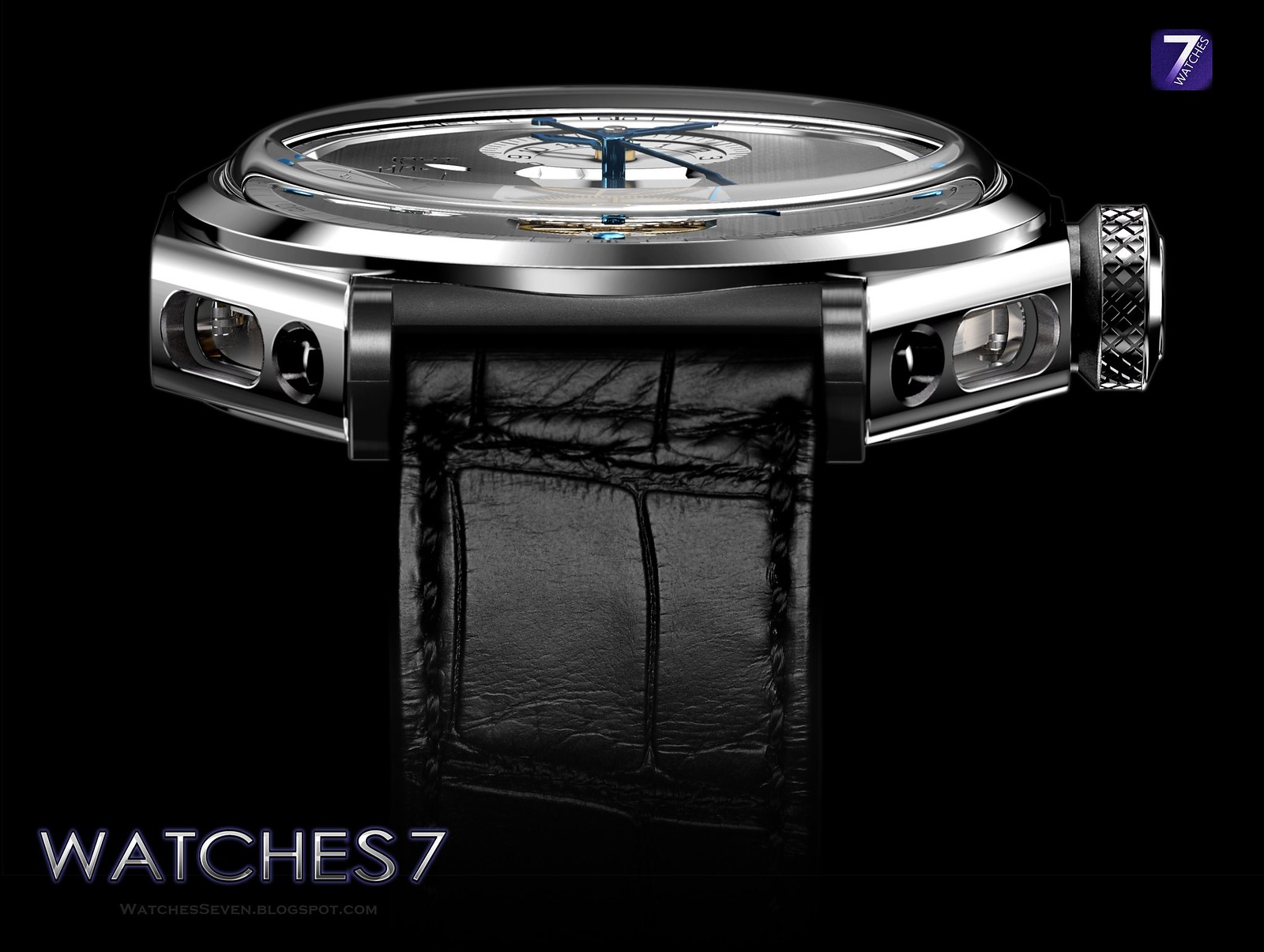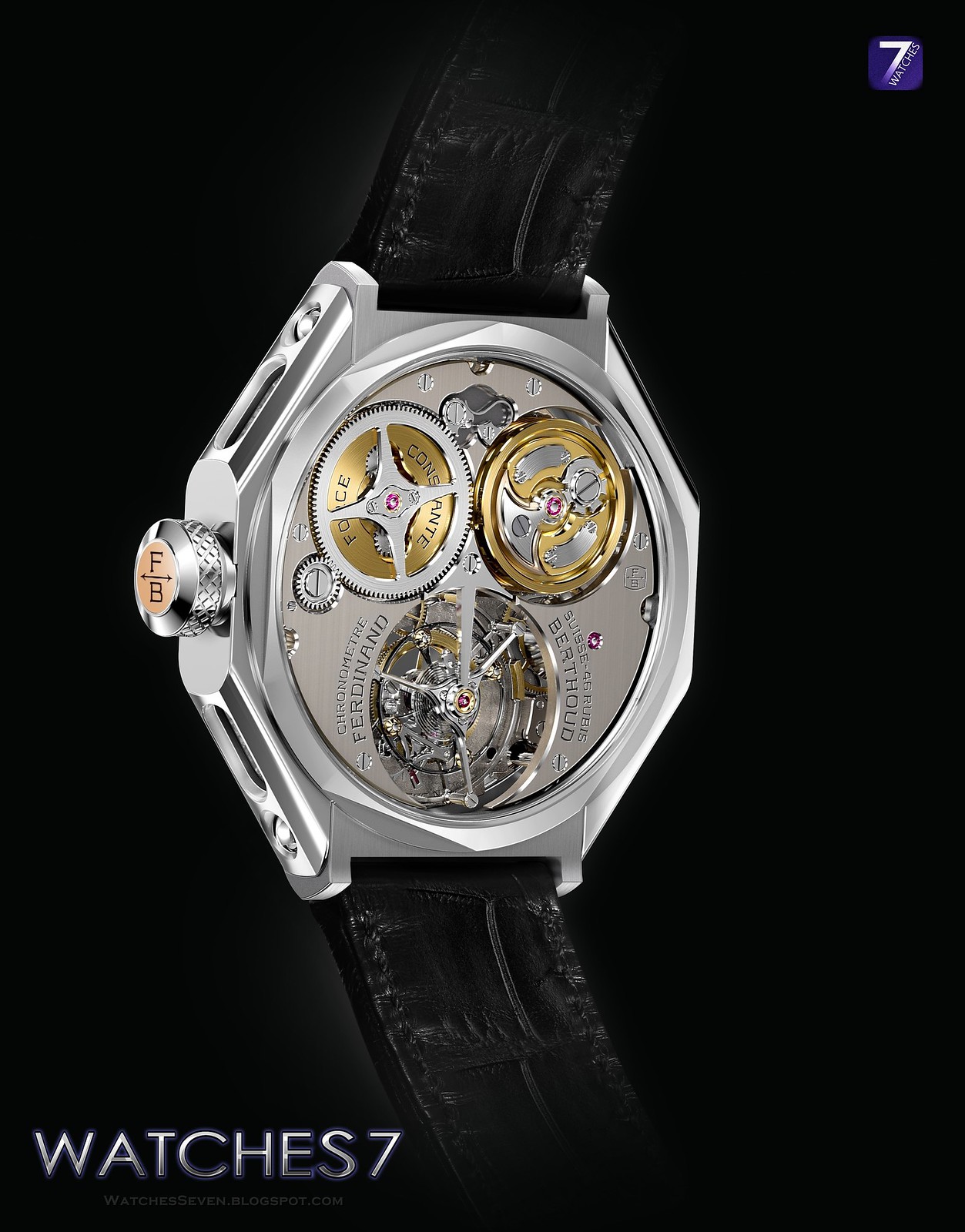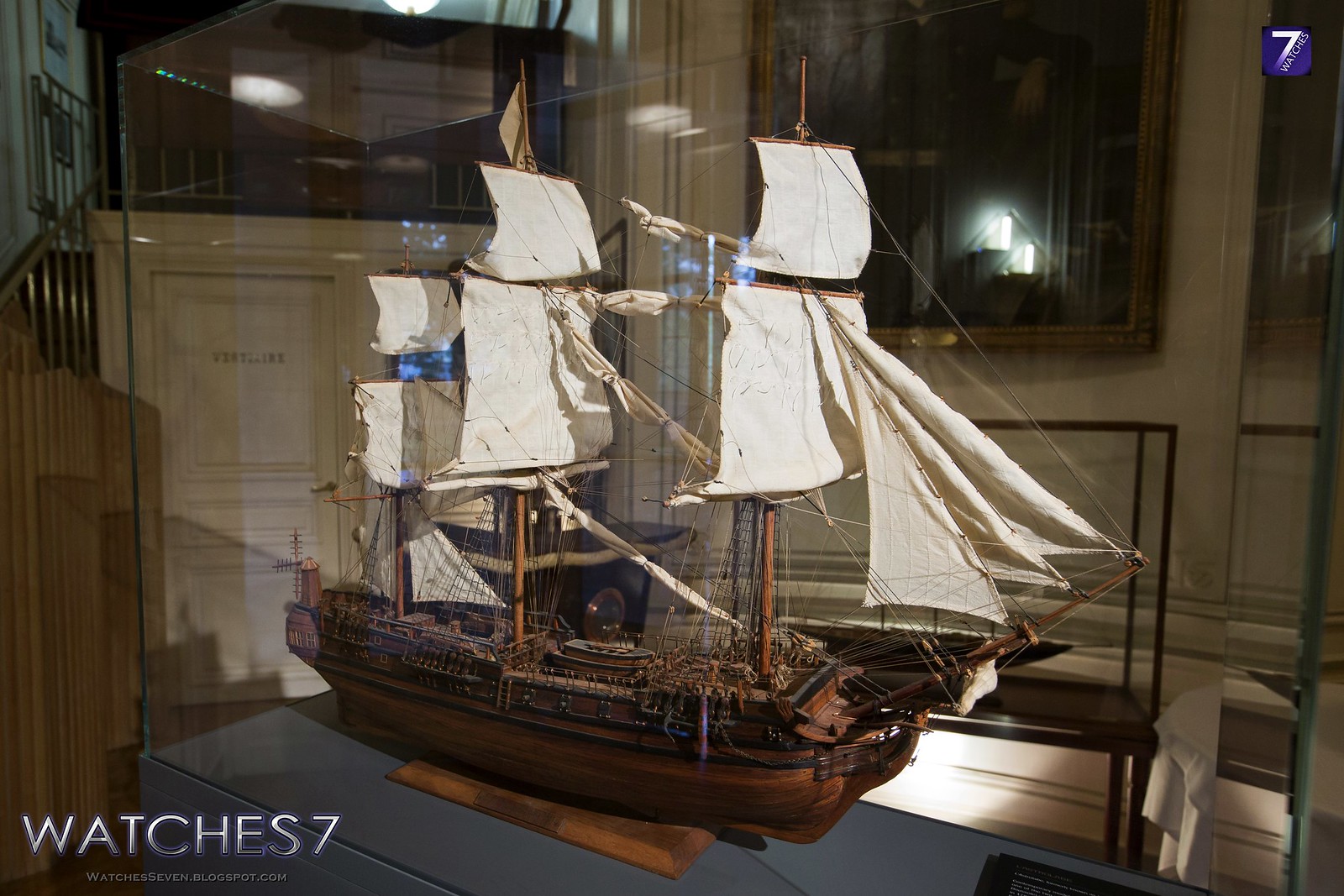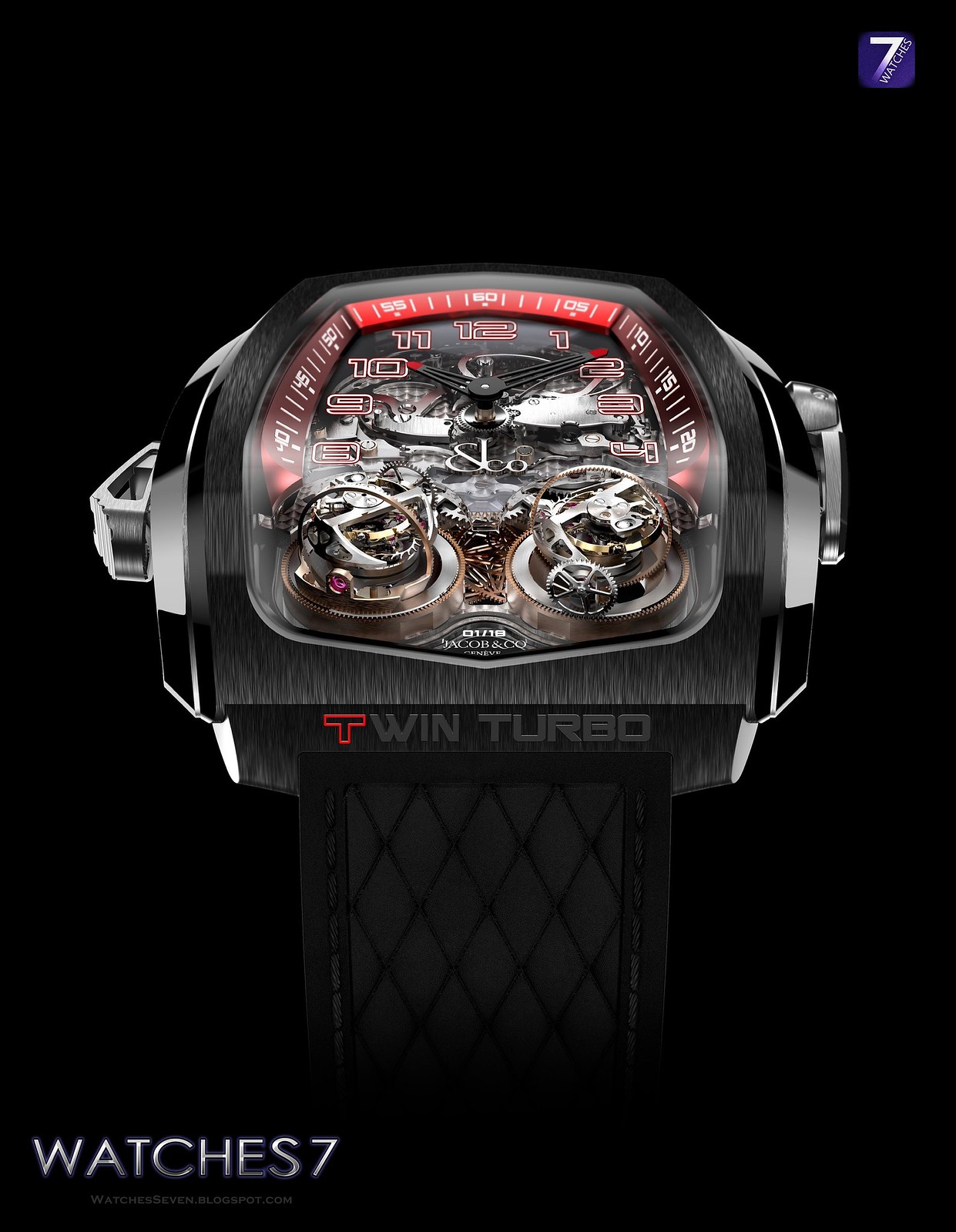FERDINAND BERTHOUD – Chronométrie Ferdinand Berthoud FB 1 Gold Limited Edition NEW
Click on the mouse wheel to see the large size ... FOTO
A modern vision of the work of Ferdinand Berthoud
Click on the mouse wheel to see the large size ... BIG FOTO
Stemming from a reflective process undertaken in tribute to the horological genius of Ferdinand Berthoud, the new timepiece from Chronométrie FERDINAND BERTHOUD embodies a modern vision of the creations that the master might create if he were still living today. Karl-Friedrich Scheufele, President of the Chronométrie FERDINAND BERTHOUD, wanted this exceptional new timepiece to represent a continuation of the work of the master chronometer-maker.
Click on the mouse wheel to see the large size ... BIG FOTO
This was to be done by adopting a contemporary approach guided by the same innovative spirit, while drawing inspiration from the marine chronometers created by the master watchmaker. Housed in an imposing octagonal case with watertight portholes, the new Chronomètre FERDINAND BERTHOUD FB 1 is equipped with an original mechanical hand-wound movement comprising more than 1,120 components.
Click on the mouse wheel to see the large size ... BIG FOTO
Entirely independently conceived, developed and produced by the Chronométrie FERDINAND BERTHOUD in Fleurier, the FB-T.FC calibre features a tourbillon with central seconds, a distinctive pillar-type architecture, an innovative suspended fusée - chain regulating system and a mobile cone indicating power-reserve. Patents have been filed for each of these features.
Click on the mouse wheel to see the large size ... BIG FOTO
Reviving a watchmaking dynasty
By giving a new lease on life to the name and the horological feats of Ferdinand Berthoud providing them with a contemporary expression, Chronométrie FERDINAND BERTHOUD ushers the talent of this accomplished chronometer-maker into a new creative era that exalts the finest aspects of the watchmaking art. This dynasty of master-watchmakers dates back to 1753 when Ferdinand Berthoud officially earned the title of Master Clockmaker in Paris.
Click on the mouse wheel to see the large size ... BIG FOTO
He established himself as one of the most talented watchmaker-engineers of his era, making an indelible mark on history with his remarkably accurate marine chronometers. Capable of measuring longitudes to within less than half a degree, the chronometers developed by Ferdinand Berthoud would enable France to vie with England for maritime supremacy – and earn their creator the prestigious title of “Horloger Mécanicien du Roi et de la Marine” - Horologist-Mechanic by appointment to the King and the Navy- under the reign of Louis XV.
Click on the mouse wheel to see the large size ... BIG FOTO
Marine clock M.M. n° 6, dated 1777 and kept in the Chopard L.U.CEUM museum in Fleurier, represents one of the main sources of inspiration that guided the rebirth of Chronométrie FERDINAND BERTHOUD. This marine chronometer is driven by a movement equipped with a constant-force module, an astonishing fusée - chain transmission system as well as a superb pillar-based construction.
Click on the mouse wheel to see the large size ... BIG FOTO
FERDINAND BERTHOUD – Horloge de marine № 6 - 1777
The new Chronomètre FERDINAND BERTHOUD FB 1 reprises these prestigious characteristic features, as well as the profound attachment to reliability and chronometric precision that are the fundamental qualities of the new watches from Chronométrie FERDINAND BERTHOUD.
Click on the mouse wheel to see the large size ... BIG FOTO
Calibre FB-T.FC: a movement housing unprecedented mechanisms
The new FERDINAND BERTHOUD Tourbillon Fusée - Chain chronometer is powered by an exclusive hand-wound movement entirely designed, developed and produced by Chronométrie FERDINAND BERTHOUD. Calibre FB-T.FC is distinguished by a striking pillar-type architecture typical of the marine chronometers created by the master-watchmaker in the 18th century. Equipped with a remarkable low-frequency (3 Hz) tourbillon with central seconds, this exceptional movement also features a constant-force regulating device with suspended fusée - chain transmission, a differential-based winding system, as well as a highly specific power-reserve mechanism called a “suspended mobile cone”.
Click on the mouse wheel to see the large size ... BIG FOTO
The result of almost three years’ research and development, culminating in cutting-edge reliability tests, Calibre FB-T.FC delivers exceptional precision and rating regularity duly certified by the Swiss Official Chronometer Testing Institute (COSC), along with 53 hours’ autonomy and optimal readability of its hours, minutes, seconds and power-reserve functions.
Click on the mouse wheel to see the large size ... BIG FOTO
Inspired by Berthoud regulator-type clocks, the particularly slim, long spokes of the gear wheels are decorated with meticulous care. Patiently circular satin-finished, bevelled and countersunk, they subtly reflect the light onto the pinions. Patents have been filed for several of the unprecedented mechanisms composing this new calibre.
Window onto an exceptional horological accomplishment
The unique architecture of the FB-T.FC calibre highlights a fascinating play on the symmetry between the barrel, the fusée and the tourbillon, visible through the generously open back of the octagonal case. Fitted on gear wheels with tapering spokes and supported by stylised pillars, the barrel, fusée and tourbillon appear to be suspended in mid-air, thereby creating an airy, light feel.
Click on the mouse wheel to see the large size ... BIG FOTO
The polished titanium pillars securing the bridges to the mainplate generate a space that draws light to the heart of the movement and reinforces the pure nature of this exceptional construction comprising more than 1,120 components within a 35.50 mm diameter and a modest 8 mm thickness.
Click on the mouse wheel to see the large size ... BIG FOTO
The entirely hand-decorated half-bridges are satin-finished and bevelled with straight-grained flanks, while the jewels are set in finely polished and chamfered chatons.
Innovative fusée - chain transmission
The characteristic fusée - chain systems of 18th century timepieces served to compensate for the variations in torque of the mainspring according to its degree of winding. The original fusée - chain mechanism of Calibre FB-T.FC occupies an exceptionally small space at the heart of the movement thanks to its “suspended” construction by which it is secured exclusively to the mainplate.
Click on the mouse wheel to see the large size ... BIG FOTO
The barrel and the fusée are linked by a 28 cm-long chain composed of 474 steel links and more than 316 pins measuring barely 0.30 mm in diameter and all hand-assembled. When the mainspring is associated with a fusée (spindle-like element), the barrel drum turns in one direction when the spring winds down and in the opposite direction when it is wound up. The rotation of the drum causes the chain to coil around the fusée. To ensure the movement does not stop during winding, the fusée mechanism of Calibre FB-T.FC is equipped with an unusual differential gear.
Click on the mouse wheel to see the large size ... BIG FOTO
The barrel itself is linked to the Maltese cross stopwork device that serves to limit the number of winding turns of the mainspring and to ensure pre-determined, constant-force transmission during the letting down process.
Fascinating power-reserve mechanism
The power-reserve device of calibre FB-T.FC is also extremely specific and innovative, inspired by a mechanism developed by the famous British watchmaker Georges Daniels – and a nod to the ties with England cultivated by Ferdinand Berthoud.
Click, to see the large size. ▶ BIG FOTO
This mechanism directly linked to the barrel by a driving wheel, uses the winding and letting down motion of the mainspring to make a truncated cone move up and down along an arbor secured to the mainplate.
Click on the mouse wheel to see the large size ... BIG FOTO
A mobile arm tipped with a roller jewel serves as a feeler-spindle in measuring the motion of the cone and transmitting the movement’s power-reserve level to a dedicated hand.
A low-frequency 3 Hz tourbillon
Fitted with a tourbillon regulating organ featuring an innovative direct-drive seconds hand, the FB-T.FC calibre is equipped with a variable-inertia balance oscillating at a low frequency of 3 Hz, while the tourbillon carriage performs one rotation per minute. The balance made of copper beryllium (CuBe), a particularly resistant copper-based alloy, is equipped with an unbreakable, stainless and anti-magnetic self-compensating balance spring whose terminal curve is delicately shaped by hand – noblesse oblige. Two sets of inertia-blocks on the balance rim enable micrometric adjustment of its amplitude.
Click on the mouse wheel to see the large size ... BIG FOTO
The 67-part titanium tourbillon carriage is held in place by a bridge with a single arch and poised by means of two 18-carat gold studs. Identical and coaxial with the wheel driving the tourbillon carriage, the central seconds wheel does exactly what its name implies by enabling a central display of the seconds. A patent request has also been filed for this unusual construction.
An octagonal case with domed crystal and water-resistant portholes
The octagonal-shaped case of the Chronomètre FERDINAND BERTHOUD FB 1 features a specific architecture inspired by the marine chronometers developed by the Swiss master-watchmaker, and in particular their gimbal suspension system typical of ship’s chronometers. The movement is housed in a water-resistant container, while the case middle takes on an octagonal shape due to the addition of screwed-on gold elements endowing it with a powerfully contemporary appearance.
Click on the mouse wheel to see the large size ... BIG FOTO
These octagonal add-on sides open onto four lateral sapphire portholes providing a chance to admire the subtle intricacies of the movement. The 44 mm-diameter case is water-resistant to 30 metres and fitted with a glareproofed screw-down sapphire back.
Click, to see the large size. ▶ BIG FOTO
It provides a captivating view of the tourbillon and reveals the complex fusée - chain mechanism. This window onto the heart of the movement allows light to flood through the case, illuminating the mechanisms visible through the four water-resistant lateral portholes.
Click on the mouse wheel to see the large size ... BIG FOTO
The pleasingly round bezel is topped by a domed, arched and glareproofed sapphire crystal ensuring optimal legibility of the dial indications. Secured by bolts whose design is directly inspired by those used by Ferdinand Berthoud for its marine clocks, the inter-horn space is clothed with high-tech materials – grade 5 titanium for the white gold version and black ceramic for the rose gold version – accentuating the resolutely modern nature of this new watch.
Click on the mouse wheel to see the large size ... BIG FOTO
The screw-lock crown at 3 o’clock is elegantly set with a rose gold medallion on the white gold case and a black ceramic version on the one in rose gold, while its generous diameter and refined knurling ensure an optimal grip enabling easy adjustments of the movement. With its harmoniously proportioned and original case graced with extremely sophisticated finishes, the new timepiece from Chronométrie FERDINAND BERTHOUD displays a unique character distinguished by pure, sparing elegance.
The face of precision
Focusing firmly on time read-off and the display of its precise measurement, the dial of the Chronomètre FERDINAND BERTHOUD FB 1 is as understated in its appearance as it is technically complex to produce. The off-set hours and minutes tick by on a white-lacquered subdial at 12 o’clock. Standing out against a black satin-brushed or ruthenium background depending on the case material, the seconds scale appears on a matt translucent sapphire surrounding the dial. In the centre, an opening with carefully chamfered contours reveals the seconds wheel-and-pinion and the driving wheel of the tourbillon carriage – each turning in the opposite direction to the other.
Click on the mouse wheel to see the large size ... BIG FOTO
Meanwhile, the movement power reserve is indicated on a scale directly engraved on the mainplate and shown at the heart of a 9 o’clock counter.
Click on the mouse wheel to see the large size ... BIG FOTO
Its degree of autonomy is signalled by an arrow pointing to the words “Haut” or “Bas” – the French terms for high and low written in the native language of Ferdinand Berthoud. Alongside the confirmation of “Chronometer” certification appearing at the bottom of the dial, the inscriptions “Val-de-Travers” and “Switzerland” underscore the hand-crafted nature of this precious timepiece entirely developed in the birthplace of the master-watchmaker.
The refinement of an authentic chronometer
Meticulous care has been lavished on the execution of the hands, inspired by the characteristic shapes of creations bearing the Ferdinand Berthoud signature. Crafted in 18-carat gold, they adopt complex and original designs calling for particularly sophisticated production processes. The dagger-shaped hours and minutes hands are cut-out and facetted, while the extremely long and slim central sweep-seconds hand is made of bronze and fitted with a round counterweight typical of Ferdinand Berthoud regulators. The power-reserve indicator features a curved triangular tip.
Click on the mouse wheel to see the large size ... BIG FOTO
Designed to match the shade of the dial, these pointers are all are delicately blued or gilded according to the version and guarantee perfect readability of the functions while enhancing the clarity of their precision.
Click on the mouse wheel to see the large size ... BIG FOTO
The understated lines and contemporary refinement of the Ferdinand Berthoud chronometer extend right the way through to the hand-sewn rolled-edge alligator leather strap.
Click on the mouse wheel to see the large size ... BIG FOTO
This supple yet sturdy wristband composed of one skin sewn with a linen thread is secured by an 18-carat gold double-blade safety folding clasp fitted with a length-adjustment device typical of the new timepieces from the House.
------------------------------------------------------------
Technical characteristics
Chronomètre FERDINAND BERTHOUD FB 1
18-carat white gold and titanium
Case:
Bimetallic in 18-carat white gold with titanium inter-horn space
Total diameter: 44 mm
Thickness 13 mm
Water resistance 30 metres
Crown in 18-carat white gold with 18-carat rose gold medallion
Octagonal case fitted with four watertight portholes in glareproofed sapphire crystal
Screw-in case-back with glareproofed sapphire crystal
Domed, arched and glareproofed sapphire crystal
Movement:
Mechanical hand-wound FB-T.FC
Total diameter 35.50 mm
Thickness 8 mm
Number of jewels 46
Frequency 21,600 vph (3 Hz)
Power reserve 53 hours
Suspended fusée - chain constant-force transmission regulation
Suspended mobile power-reserve cone – 3 Hz low-frequency tourbillon with central seconds
Balance-spring with hand-shaped Philips terminal curve
Nickel silver half-bridges supported by stylised titanium pillars
Chronometer-certified (COSC)
Dial and hands:
Vertical satin-finish ruthenium dial with cut-out centre
18-carat blued gold hours, minutes and power-reserve hands
Blued bronze seconds hand
Functions and displays:
Display of the hours, minutes at 12 o’clock on a white lacquered dial
Power-reserve display in an openworked subdial at 9 o’clock
Tourbillon at 6 o’clock
Strap and buckle:
Hand-sewn rolled-edge alligator leather strap
18-carat white gold double-blade length-adjustable safety folding clasp
Ref FB 1.1 – in 18-carat white gold and titanium
50-piece limited and numbered edition
-------------------------------------------------------------
Technical characteristics
Chronomètre FERDINAND BERTHOUD FB 1
18-carat rose gold and black ceramic
Case:
Bimetallic in 18-carat rose gold with black ceramic inter-horn space
Total diameter: 44 mm
Thickness 13 mm
Water resistance 30 metres
Crown in 18-carat rose gold with black ceramic medallion
Octagonal case fitted with four watertight portholes in glareproofed sapphire crystal
Screw-in case-back with glareproofed sapphire crystal
Domed, arched and glareproofed sapphire crystal
Movement:
Mechanical hand-wound FB-T.FC
Total diameter 35.50 mm
Thickness 8 mm
Number of jewels 46
Frequency 21,600 vph (3 Hz)
Power reserve 53 hours
Suspended fusée - chain constant-force transmission regulation
Suspended mobile power-reserve cone – 3 Hz low-frequency tourbillon with central seconds
Balance-spring with hand-shaped Philips terminal curve
Nickel silver half-bridges supported by stylised titanium pillars
Chronometer-certified (COSC)
Dial and hands:
Vertical satin-finish black dial with cut-out centre
18-carat blued gold hours, minutes and power-reserve hands
Blued bronze seconds hand
Functions and displays:
Display of the hours, minutes at 12 o’clock on a white lacquered dial
Seconds display at 6 o’clock
Power-reserve display in an openworked subdial at 9 o’clock
Tourbillon at 6 o’clock
Strap and buckle:
Hand-sewn rolled-edge alligator leather strap
18-carat white gold double-blade length-adjustable safety folding clasp
Ref FB 1.2 – in 18-carat rose gold and black ceramic
50-piece limited and numbered edition
Click on the mouse wheel to see the large size ... BIG FOTO
------------------------------------------------------------------------------------------------------------------------------------------
Click on the mouse wheel to see the large size ... BIG FOTO
1727-1807
Horologist-mechanic by appointment to the King
and the Navy
1727 Ferdinand
Berthoud is born on March 18 to a distinguished family of clockmakers at
Plancemont in the Val-de-Travers, now in Switzerland’s canton of Neuchâtel.
1745 At
the age of 18, Ferdinand Berthoud settles in Paris to study clockmaking.
1753 A
decree of King Louis XV’s council awards the 26-year-old Ferdinand Berthoud the
title of Master Clockmaker.
1755 Ferdinand
Berthoud writes a number of reference papers for the Encyclopédie méthodique edited by Diderot (1713-1784) and
Alembert (1717-1783).
1763 Publication
of a two-volume horological treatise, Essai
sur l’horlogerie…
1764 Ferdinand
Berthoud is elected to the Royal Society in London as an “associate overseas
member” thanks to his masterpieces and his publications about watchmaking
1768 The
marine chronometers N° 6 and N° 8 were proved to be successful onboard the
corvette “L’Isis” during a 18-month journey from Rochefort to Santo Domingo.
The marine chronometer N°8 alloed to determine the real position on the map of
the boat and calculate the longitude within half a degree thanks to
astronomical observations.
1770 After
successful sea trials of the marine chronometers N° 6 and N° 8, Ferdinand
Berthoud is commissioned as
Horologist-mechanic to the King and the Navy, and receives a royal command
for 20 marine chronometers for the French admiralty’s numerous charting
expeditions and marine surveys of the late 18th century.
1802 Ferdinand
Berthoud publishes a major work: Histoire de la mesure du temps par les
horloges, a history of time measurement by clocks that demonstrates his
immense knowledge of horological mechanics.
1804 On July 17, Napoleon I makes Ferdinand
Berthoud a Knight of the Legion of
Honour as a member of the Institut de France.
1807 Ferdinand
Berthoud publishes his last work, Supplément
au Traité des montres à Longitudes…
On June 20, 1807, Ferdinand Berthoud dies at
the age of 80 in Groslay (France)
His
nephews, Pierre-Louis Berthoud (1754-1813) and Charles-Auguste Berthoud
(1798-1876) successfully carry on the work of their uncle to earn renown as
chronometer-makers.
----------------
----------------
Click on the mouse wheel to see the large size ... BIG FOTO
-------------------------------------------------------------
Chronométrie FERDINAND BERTHOUD SA
Rue des Moulins 20
Case postale 128
2114 Fleurier, Val-de-Travers (NE)
Switzerland
-------------------------------------------------------------------
www.facebook.com - Ferdinand Berthoud
----------------------------------------------------------------------------
www.FerdinandBerthoud.ch

